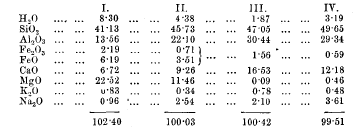Article contents
II.—On Bastite-Serpentine and Troktolite in Aberdeenshire, with a Note on the Rock of the Black Dog
Published online by Cambridge University Press: 01 May 2009
Extract
In a paper entitled “On Minerals new to Britain,” published in the Mineralogical Magazine, vol. v. p. 1, Professor Heddle mentions the occurrence of a bastite-serpentine at two localities in Aberdeenshire; one in the parish of Belhelvie, the other on the shore close to a curious rock named the Black Dog. A visit to the localities has enabled me to add to his account some particulars, and to offer one or two corrections which seem to me not unimportant.
- Type
- Original Articles
- Information
- Copyright
- Copyright © Cambridge University Press 1885
References
page 439 note 2 In this paper the term mineral is used in a very wide sense, as it includes tachylyte, Lydian-stone, chert, lignite, spherulite, and pitchstone. If all of these are minerals, what are left to us as rocks?
page 440 note 1 It is marked on Dr. A. Geikie's Geol. Map of Scotland.
page 441 note 1 Plate viii. figs. 2 and 3 (one of the peridotite of the Hartz, the other of that from Christiania) in Dr. Wadsworth's Lithologioal Studies, part i. would very fairly illustrate the serpentine described in this paper.
page 442 note 1 I append the analyses made or quoted by Mr. Houghton. I. is the Volpersdorf rock, II. that of Coverack, III. the felspar of No. 1′., IV. the felspar of No. II. From the latter two it is evident the Còverack rock contains rather more labradorite than the Volpersdorf rock. I think, however, that the specimen analysed of the latter rock must have been a little richer than common in olivine.

page 442 note * Mr. Brown adds, “The values of these are uncertain–the numbers given are the means of two experiments: the limits between which the value may lie are Na2O 1·85 to 2·33, K2O 1·19 to ·71.—Total 3·04.”
page 444 note 1 These or other microliths sometimes pierce the felspathic part of the slide in a way that recalls the canal system of Eozoon, but to discuss this would require too long a digression for the present occasion.
page 444 note 2 Boulders are not common on this part of the shore. In fact, I do not remember observing one for about a mile and a half to the south, so that the rock probably is either in situ or has come from the immediate neighbourhood.
page 445 note 2 Comparison of these renders it highly probable that II. was more completely freed from the olivine grains than I.
- 1
- Cited by




